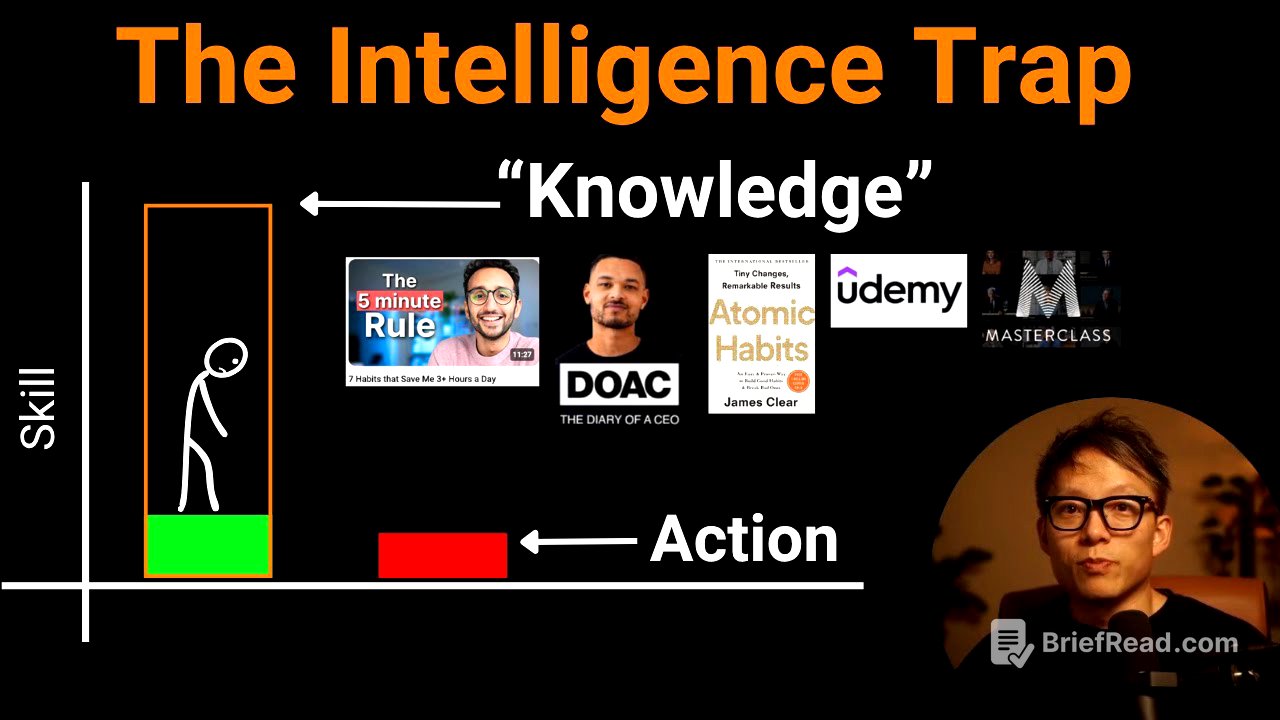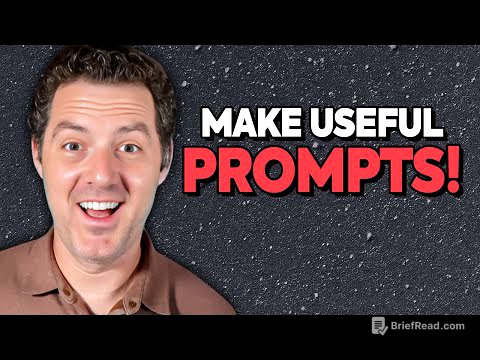TLDR;
This video discusses the "intelligence trap," where overthinking and excessive planning lead to inaction. It introduces the concepts of the "strategist" and the "performer" within oneself, highlighting how an overdeveloped strategist can hinder the performer's ability to take action. The video also addresses the role of the self-help industry in profiting from hesitation and offers a framework for upgrading the "performer" through simplicity, safety, and pressure.
- The "intelligence trap" is when overthinking and planning lead to inaction.
- The self-help industry profits from people's hesitation and search for more knowledge.
- Upgrading the "performer" requires simplicity, safety, and pressure.
The Intelligence Trap [0:00]
The video starts by posing the question of why individuals often find themselves doing less as they think more about their projects. It suggests that people can become trapped by their own intelligence and knowledge, especially those who are smarter. The video aims to break down the concept of the intelligence trap, explain why many self-help tools can worsen the problem, discuss how survival instincts contribute to being stuck, and reveal how an industry profits from people's hesitation. The core issue is that despite having intelligence and tools, individuals struggle to take action, often because they focus on learning and planning excessively, believing that knowledge equates to power.
The Strategist vs Performer [1:00]
The video introduces the idea of two entities within a person's mind: the strategist and the performer. The strategist enjoys thinking, analyzing, and planning, while the performer is responsible for taking action and doing the actual work. The strategist finds intellectual stimulation in planning, whereas the performer experiences discomfort, fear, and doubt when faced with the task of executing those plans. Over time, education and societal structures tend to reward the strategist, leading to an atrophy of the performer. As a result, the strategist becomes powerful and enjoys complex planning, which overwhelms the performer, leading to paralysis, loss of confidence, and self-doubt.
How Overthinking Creates Avoidance [3:00]
As one approaches the point of starting a project, the performer begins to avoid it due to fear. This avoidance manifests in various ways, such as getting stuck in the knowledge acquisition stage, experiencing shiny object syndrome, perfecting plans endlessly, building portfolio projects without shipping anything, and constantly seeking more courses. The strategist, with its love for complex plans, lacks empathy for the performer's struggles, leading to frustration and punishment of the performer. The performer, overwhelmed by complex plans, makes errors, gets frustrated, and resorts to unproductive activities like doom scrolling on YouTube. This creates a negative cycle where the strategist seeks more knowledge, while the performer struggles to take action, leading to a hollow and empty feeling.
The Uncertainty Trap [5:00]
When one finally decides to act, the brain starts calculating all the risks involved. Intelligent individuals tend to calculate more risks, leading to feelings of fear, uncertainty, self-doubt, lack of confidence, and imposter syndrome. This results in a "runaway loop" where uncertainty leads to consuming more information for comfort, but the feeling returns upon attempting to act. As more is learned, the realization of how much is still unknown increases, intensifying the feeling of being overwhelmed. The paradox is that the more one knows, the less one does, leading to even greater uncertainty.
The Industry That Profits From Hesitation [6:10]
The video highlights that paralysis is profitable for the self-help industry. While individuals are stuck trying to figure things out, they are drawn to consume more knowledge, which feeds the strategist rather than helping the performer. This creates a loop where creators, courses, and thought leaders thrive by selling the illusion of progress, providing an emotional sugar rush of learning without doing. The market rewards attention, not results, as evidenced by the focus on "best sellers," which are marked on the number of books sold, not their effectiveness. Many people buy self-help books but struggle to implement the knowledge within them, becoming individuals who are always about to start things.
Survivorship Bias in Self-Help [9:30]
The video addresses the survivorship bias in the self-help industry, noting that while some people experience success with courses and training, many others struggle. Research indicates that only 5% to 15% of people complete online courses, meaning that 85% to 95% never reach the finish line. Even among those who complete courses, not all achieve the desired results. Often, course creators genuinely believe they are helping based on their own experiences, but they have a critical blind spot: they don't consider how similar they are to the people they are trying to help. Courses and products work best when the performer is already skillful and needs the right information, allowing the strategist and performer to work in sync. However, many individuals are over-indexed with the strategist and struggle with having a competent performer.
The Hidden Cost [15:45]
The video discusses the hidden costs of being trapped in the intelligence trap. Despite having a bookshelf full of self-help books, many individuals fail to achieve real outcomes. The system is designed to create buyers, not necessarily finishers. The hidden cost includes more failures in private, loss of confidence, and an identity of feeling intelligent but useless. Ultimately, individuals lose trust and belief in themselves. The goal is to have both the strategist and performer working well together, but for many, the performer is underdeveloped and needs retraining to start executing again.
The Performer Upgrade Framework [17:10]
The video introduces the performer upgrade framework, emphasizing that one cannot think their way out of the intelligence trap but must train their way out. The performer does not need more knowledge but a different environment that encourages the right behaviors. This is akin to rebuilding a muscle by actively using it at the right load. The performer needs simplicity, safety, a sense of pressure to perform, and good feedback. Simplicity involves breaking down complex plans into small, clear steps. Safety helps deal with the fear of failure through controlled exposure to risk, creating psychological safety.
Why Pressure Beats Motivation [20:20]
Pressure is the force that pushes one past friction and avoidance. The right amount of pressure is needed to overcome the avoidance sensation that the performer instinctively exhibits to avoid negative feelings. Deadlines, accountability, and social pressure can be used to create this override. The goal is to make it more painful to stay in the current state than to move forward. Feelings like embarrassment, fear of missing out, or being left behind can be leveraged. Nearly everyone already knows the types of pressures that work for them.
Why External Pressure Works Better Than Discipline [25:50]
External pressure works better than internal motivation because it creates stakes that the brain takes seriously. Stakes often come naturally when working with others, such as clients, customers, teams, friends, or family. The performer wakes up because they sense real consequences. Different people have different values, so the pain of slipping on a deadline or not showing up for someone depends on how much they care about the person or task. The mistake many people make is thinking they can create pressure for themselves, but self-imposed deadlines and accountability often fail because there are no real stakes. This trains the performer that not showing up is acceptable, making them worse.
Introducing the 20-Hour Challenge [27:30]
The video introduces the 20-Hour Challenge, a project designed to create structured containers in a group setting to help rebuild the performer. Participants join a group of people all trying to rebuild their performers, with live accountability, tracking, and graduation. The challenge includes deadlines, hour tracking, and progress logs to create pressure and encourage execution. In the first cohort, 78% of participants finished their projects. The video encourages viewers to check out the landing page, read testimonials, and take a free assessment to see if the challenge is a good fit for them.
The Real Formula for Confidence [30:40]
The hidden pattern is that every time one avoids discomfort, the performer gets weaker, and every time one faces it, even in tiny doses, confidence starts to compound. Each time one shows up, it's evidence that the performer is capable. Individuals are not broken but deconditioned. The strategist has been training for years, while the performer has atrophied. Closing this gap allows one to start winning.
Final Message [31:40]
The video concludes by reiterating that individuals do not need more information or training but a training ground and an environment that will help them move forward. Viewers are encouraged to check out the beta program and potentially join on the other side.









